1994 OLDSMOBILE SILHOUETTE fuel
[x] Cancel search: fuelPage 183 of 276

Here you will find information about
the care of
your Oldsmobile . This
part begins with service and fuel
information. and then it shows how
to check important fluid and
lubricant levels
. There is also
technical information about
your
vehicle. and a section devoted to its
appearance care
.
Part 6
Service & Appearance Care
Service ........................................................................\
............................................. 182
Fuel
........................................................................\
.................................................. 183
Hood Release ........................................................................\
................................... 186
Engine Oil ........................................................................\
........................................ 190
Air Cleaner
........................................................................\
...................................... 194
Transaxle Fluid
........................................................................\
................................ 195
Engine Coolant
........................................................................\
................................ 197
Power Steering Fluid
........................................................................\
....................... 199
Windshield Washer Fluid
........................................................................\
................ 200
Brakes
........................................................................\
.............................................. 201
Battery
........................................................................\
............................................. 203
Bulb Replacement
........................................................................\
........................... 203
Windshield Wiper Blade Replacement
................................................................... 205
Loading Your Vehicle
........................................................................\
..................... 206
Tires
........................................................................\
................................................. 207
Appearance Care ........................................................................\
............................. 212
Vehicle Identification Number (VIN)
.................................................................... 218
Add-on Electrical Equipment
........................................................................\
........ 219
Fuses & Circuit Breakers ........................................................................\
................ 219
Capacities and Specifications
........................................................................\
......... 224
Normal Maintenance Replacement Parts
............................................................... 226
Fluids
& Lubricants ........................................................................\
........................ 227
Replacement
Bulbs ........................................................................\
.......................... 228
181
ProCarManuals.com
Page 185 of 276
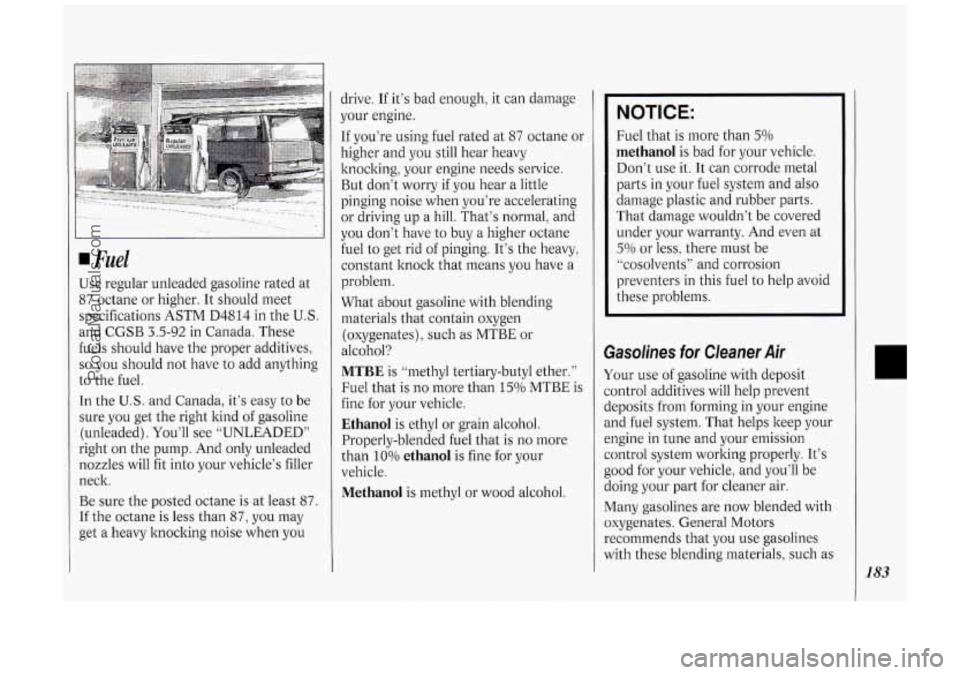
Fuel
Use regular unleaded gasoline rated at
87 octane or higher. It should meet
specifications
ASTM D4814 in the U.S.
and CGSB 3.5-92 in Canada. These
fuels should have the proper additives,
so you should not have to add anything
to the fuel.
In the
U.S. and Canada, it’s easy to be
sure you get the right kind
of gasoline
(unleaded). You’ll see “UNLEADED”
right on the pump. And only unleaded
nozzles will fit into your vehicle’s filler
neck.
Be sure the posted octane is at least
87.
If the octane is less than 87, you may
get
a heavy knocking noise when you drive.
If it‘s bad enough, it can damage
your engine.
If you’re using fuel rated at 87 octane or
higher and you still hear heavy
knocking, your engine needs service.
But don’t worry if you hear a little
pinging noise when you’re accelerating
or driving up a hill. That’s normal, and
you don’t have to buy a higher octane
fuel to get rid of pinging. It’s the heavy,
constant knock that means you have a
problem.
What about gasoline with blending
materials that contain oxygen
(oxygenates), such as MTBE or
alcohol?
MTBE is “methyl tertiary-butyl ether.”
Fuel that
is no more than 15% MTBE is
fine for your vehicle.
Ethanol is ethyl or grain alcohol.
Properly-blended fuel that is no more
than
10% ethanol is fine for your
vehicle.
Methanol is methyl or wood alcohol.
NOTICE:
Fuel that is more than 5%
methanol is bad for your vehicle.
Don’t use it. It can corrode metal
parts in your fuel system and also
damage plastic and rubber parts.
That damage wouldn’t be covered
under your warranty. And even at
5% or less, there must be
“cosolvents” and corrosion
preventers in this fuel to help avoid
these problems.
Gasolines for Cleaner Air
Your use of gasoline with deposit
control additives will help prevent
deposits from forming in your engine
and fuel system. That helps keep your
engine in tune and your emission
control system working properly. It’s
good for your vehicle, and you’ll be
doing your part for cleaner air.
Many gasolines are now blended with
oxygenates. General Motors
recommends that you use gasolines
with these blending materials, such as
183
ProCarManuals.com
Page 186 of 276

Service &Appearance Care
184
MTBE and ethanol. By doing so, you
can help clean the air, especially in
those parts
of the country that have
high carbon monoxide levels.
In addition, some gasoline suppliers are
now producing reformulated gasolines.
These gasolines are specially designed
to reduce vehicle emissions. General
Motors recommends that you use
reformulated gasoline. By doing
so, you
can help clean the air, especially in
those parts
of the country that have
high ozone levels.
You should ask your service station
operators if their gasolines contain
deposit control additives and
oxygenates, and if they have been
reformulated to reduce vehicle
emissions.
Fuels in Forei’ Countries
If you plan on driving in another
country outside the
U.S. or Canada,
unleaded
fuel may be hard to find. Do
not use leaded gasoline. If you use even
one tankful, your emission controls
won’t work well or at all. With
continuous use, spark plugs can get
fouled, the exhaust system can corrode,
and your engine
oil can deteriorate
quicltly. Your vehicle’s oxygen sensor
will be damaged.
All of that means
costly repairs that wouldn’t be covered
by your warranty.
To check on fuel availability, ask an
auto club, or contact a major oil
company that does business in the
country where you’ll be driving.
You can also write us at the following
address for advice. Just tell
us where
you’re going and give your Vehicle
Identification Number (VIN).
General Motors Overseas
Distribution Corporation
North American Export Sales (NAES)
1908 Colonel Sam Drive
Oshawa, Ontario
L1H 8P7
ProCarManuals.com
Page 187 of 276
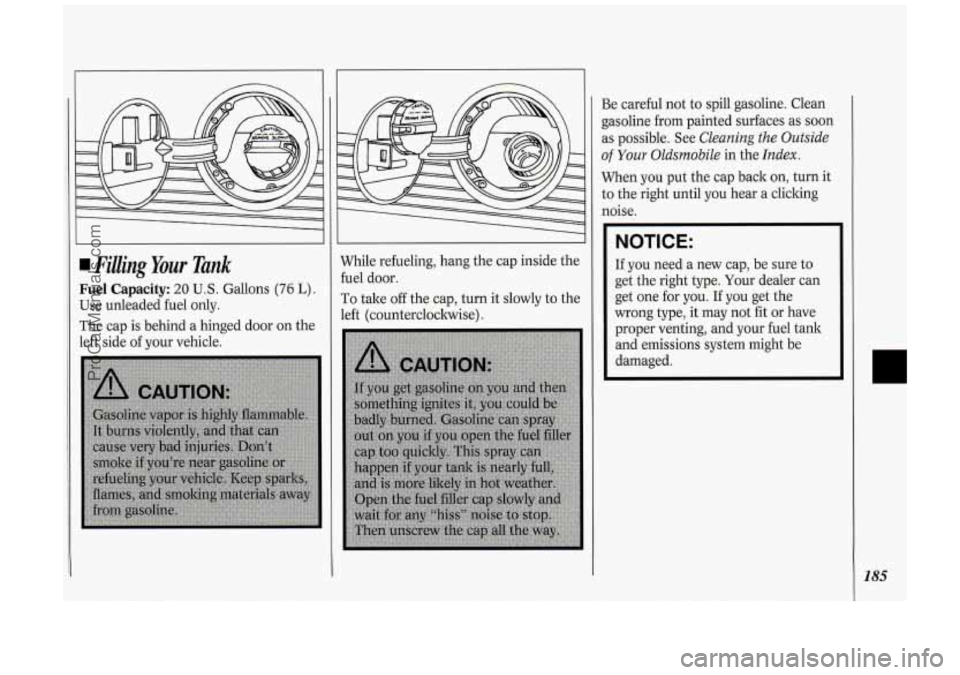
Filling Your Tank
Fuel Capacity: 20 U.S. Gallons (76 L).
Use unleaded fuel only.
The cap is behind a hinged door on the
left side of your vehicle. While
refueling, hang the cap inside the
fuel door.
To take off the cap, turn it slowly to the
left (countercloclnvise)
.
Be careful not to spill gasoline. Clean
gasoline from painted surfaces as soon
as possible. See
Cleaning the Outside
of Your Oldsmobile in the Index.
When you put the cap back on, turn it
to the right until you hear a clicking
noise.
NOTICE:
If you need a new cap, be sure to
get the right type. Your dealer can
get one for you. If you get the
wrong type, it may not fit or have
proper venting, and your fuel tank
and emissions system might be
damaged.
185
ProCarManuals.com
Page 192 of 276
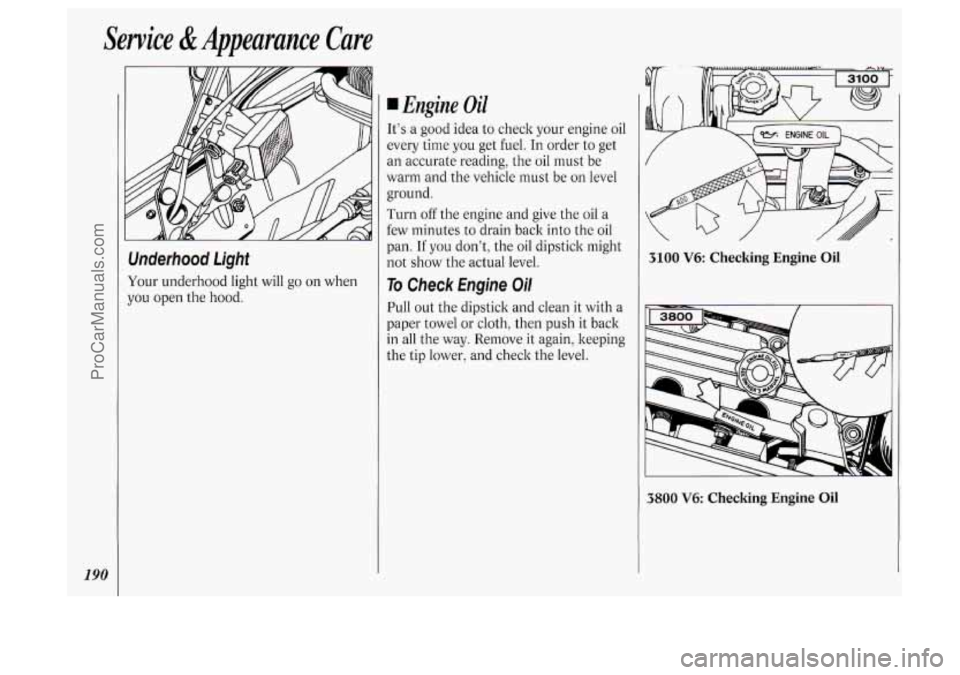
Service &Appearance Care
190
Underhood Light
Your underhood light will go on when
you open the hood.
Engine Oil
It’s a good idea to check your engine oil
every time you get fuel. In order to get
an accurate reading, the oil must be
warm and the vehicle must be on level
ground.
Turn off the engine and give the oil a
few minutes to drain back into the oil
pan.
If you don’t, the oil dipstick might
not show the actual level.
To Check Engine Oil
Pull out the dipstick and clean it with a
paper towel or cloth, then push it back
in all the way. Remove it again, keeping
the tip lower, and check the level.
3100 V6: Checking Engine Oil
3800 V6: Checking Engine Oil
ProCarManuals.com
Page 194 of 276
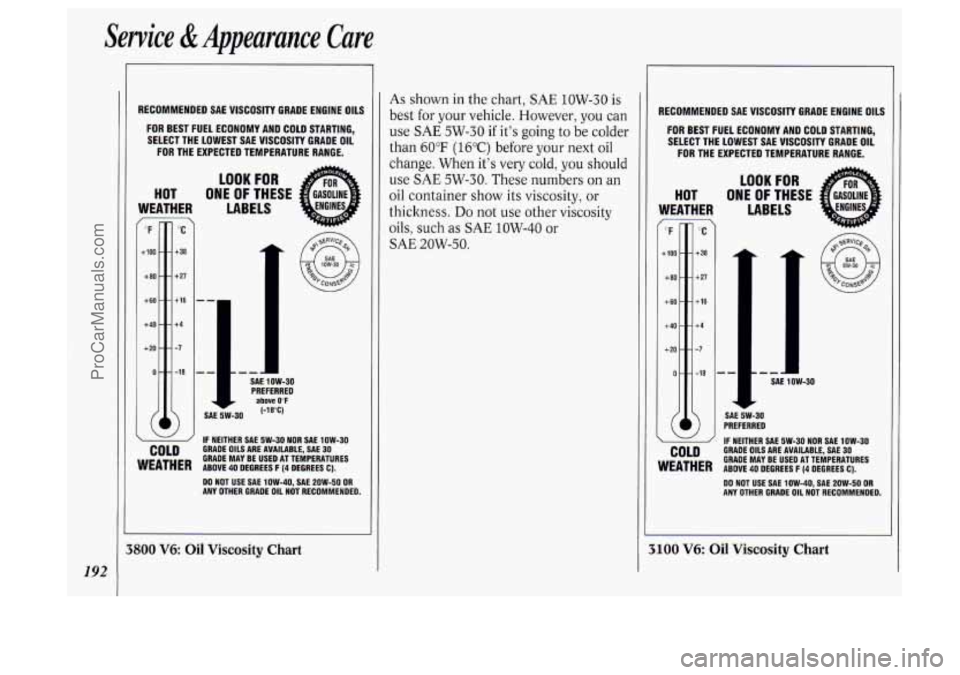
Service &Appearance Care
192
RECOMMENDED SAE VISCOSITY GRADE ENGINE OILS
FOR BEST FUEL ECONOMY AND COLD STARTING,
SELECT THE LOWEST SAE VISCOSITY GRADE OIL
FOR THE EXPECTED TEMPERATURE RANGE.
LOOK FOR
HOT ONE OF THESE
WEATHER LABELS
t100 .
+80 -
+60 -
+40 -
+20 -
0-
“C
+38
+27
+16
+4
-7
-18
COLD
SAE 1OW-30 PREFERRED above 0°F
SAE 5W-30 (-18°C)
1 IF NEITHER SAE 5W-30 NOR SAE 1OW-30 GRADE OILS ARE AVAILABLE, SAE 30 GRADE MAY BE USED AT TEMPERATURES WEATHER ABOVE 40 DEGREES F (4 DEGREES c).
DO NOT USE SAE 1OW-40, SAE 2OW-50 OR ANY OTHER GRADE OIL HOT RECOMMENDED.
2300 V6: Oil Viscosity Chart
As shown in the chart, SAE 1OW-30 is
best for your vehicle. However, you can
use SAE 5W-30 if it’s going to be colder
than
60°F (16°C) before your next oil
change. When it’s very cold,
you should
use
SAE 5W-30. These numbers on an
oil container show its viscosity, or
thickness.
Do not use other viscosity
oils, such
as SAE 1OW-40 or
SAE 20W-50.
RECOMMENDED SAE VISCOSITY GRADE ENGINE OILS
FOR BEST FUEL ECONOMY AND COLD STARTING,
SELECT THE LOWEST SAE VISCOSITY GRADE OIL
FOR THE EXPECTED TEMPERATURE RANGE.
‘-’ F
+loo
+80
+ 60
+40
+20
0
“C
+38
+ 27
+16
+4
-7
-18
LOOK FOR
LABELS
HOT ONE
OF THESE
- SAE I 1
OW-30
SAE 5W-30 PREFERRED
IF NEITHER SAE
5W-30 NOR SAE 1OW-30 GRADE OILS ARE AVAILABLE. SAE 30 COLD
WEATHER ABOVE 40 DEGREES F (4 DEGREES c).
GRADE
MAY BE USED AT TEMPERATURES
DO NOT USE SAE
1OW-40, SAE 2OW-50 OR ANY OTHER GRADE OIL NOT RECOMMENDED.
3100 V6: Oil Viscosity Chart
ProCarManuals.com
Page 195 of 276
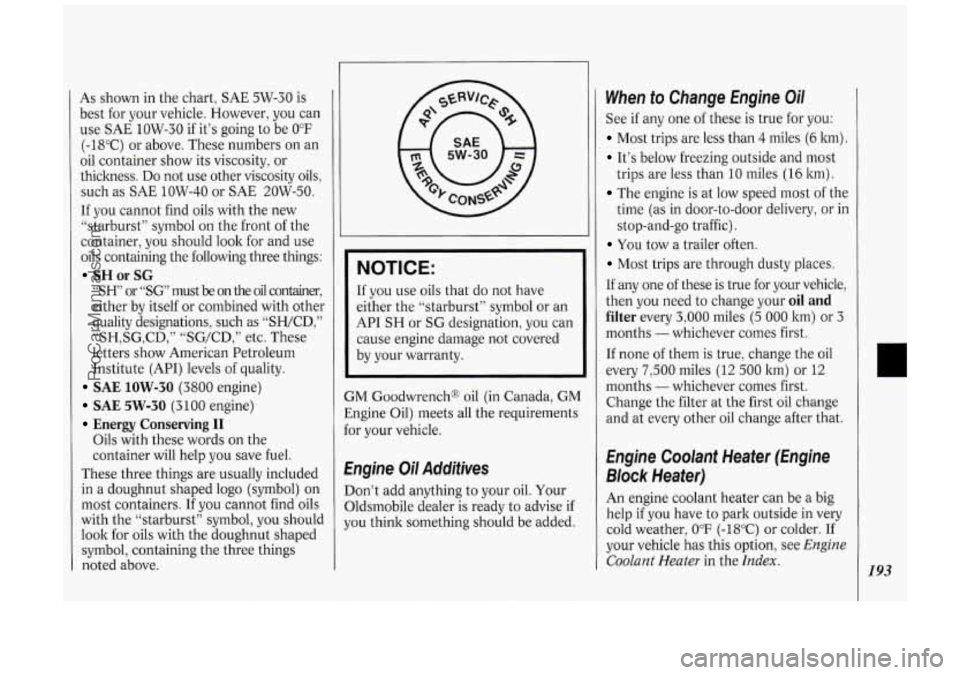
As shown in the chart, SAE 5W-30 is
best for your vehicle. However, you can
use SAE 1OW-30 if it’s going
to be 0°F
(-18°C) or above. These numbers on an
oil container show
its viscosity, or
thickness.
Do not use other viscosity oils,
such as SAE 1OW-40 or SAE 20W-50.
If you cannot find oils with the new
“starburst” symbol on the front of the
container, you should look for and use
oils containing the following three things:
SH or SG
“SH’ or “SG’ must be on the oil container,
either by itself or combined with other
quality designations, such as “SHKD,”
“SH,SG,CD,” “SG/CD,” etc. These
letters show American Petroleum
Institute (API) levels of quality.
SAE 1OW-30 (3800 engine)
SAE 5W-30 (3100 engine)
Energy Conserving I1
Oils with these words on the
container will help you save fuel.
These three things are usually included
in a doughnut shaped logo (symbol) on
most containers.
If you cannot find oils
with the “starburst” symbol,
you should
look for oils with the doughnut shaped
symbol, containing the three things
noted above. If
you use oils that do not have
either the “starburst” symbol or an
API SH or
SG designation, you can
cause engine damage not covered
by your warranty.
GM Goodwrench@ oil (in Canada, GM
Engine Oil) meets all the requirements
for your vehicle.
Engine Oil Additives
Don’t add anything to your oil. Your
Oldsmobile dealer is ready to advise if
you think something should be added.
When to Change Engine Oil
See if any one of these is true for you:
Most trips are less than 4 miles (6 ltm).
It’s below freezing outside and most
trips are less than
10 miles (16 ltm).
The engine is at low speed most of the
time
(as in door-to-door delivery, or in
stop-and-go traffic).
You tow a trailer often.
Most trips are through dusty places.
If any one of these is true for your vehicle,
then you need to change your
oil and
filter every 3,000 miles (5 000 ltm) or 3
months - whichever comes first.
If none
of them is true, change the oil
every
7,500 miles (12 500 ltm) or 12
months -whichever comes first.
Change the filter at the first oil change
and at every other oil change after that.
Engine Coolant Heater (Engine
Block Heater)
An engine coolant heater can be a big
help if you have to park outside in very
cold weather,
0°F (-18°C) or colder. If
your vehicle has this option, see
Engine
Coolant Heater in the Index. 193
ProCarManuals.com
Page 208 of 276
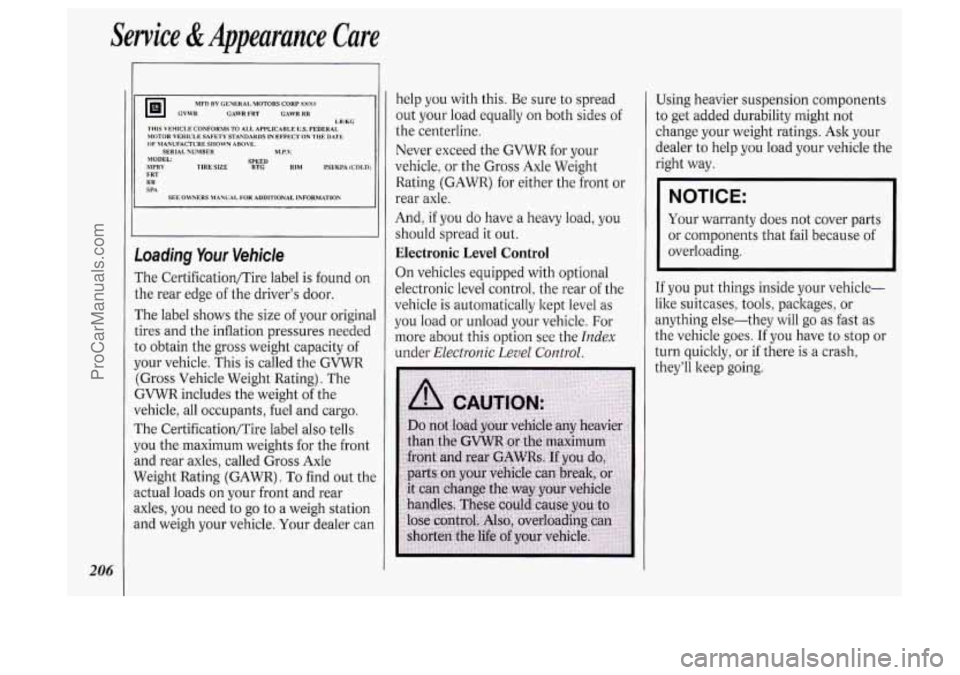
Service &Appearance Care
206
GVWR CAWR FRT CAWR RR
THIS VEHICLE CONFORMS TO ALL APPLICABLE US. FEDERAL
MOTOR VEHICLE SAFETY STANDARDS IN EFFECT ON THE DATE
OF MANUFALTURESHOWN ABOVE.
.MODEL.
M.P.V.
MPHY FRT TlRESlZE
RTG RIM WliKP, (COLD1
RR SPA MFD
fly GENERAL MOTORS CORP XWXX
LWKG
SERIAI. NUMBER SPEED
SEE
OWNERS MANUAL FOR ADDI'TIONAL INFORMATlOh
Loading Your Vehicle
The Certification/Tire label is found on
the rear edge of the driver's door.
The label shows the size
of your original
tires and the inflation pressures needed
to obtain the gross weight capacity
of
your vehicle. This is called the GVWR
(Gross Vehicle Weight Rating). The
GVWR includes the weight of the
vehicle, all occupants, fuel and cargo.
The Certification/Tire label also tells
you the maximum weights for the front
and rear axles, called Gross Axle
Weight Rating (GAWR).
To find out the
actual loads
on your front and rear
axles, you need to go to a weigh station
and weigh your vehicle, Your dealer can help
you with
this. Be sure to spread
out your load equally on both sides
of
the centerline.
Never exceed the
GVWR for your
vehicle, or the Gross Axle Weight
Rating (GAWR) for either the front or
rear axle.
And,
if you do have a heavy load, you
should spread it out.
Electronic Level Control
On vehicles equipped with optional
electronic level control, the rear
of the
vehicle is automatically kept level as
you load or unload your vehicle. For
more about this option see the
Index
under Electronic Level Control.
Using heavier suspension components
to get added durability might not
change your weight ratings. Ask your
dealer to help you load your vehicle the
right way.
NOTICE:
Your warranty does not cover parts
or components that fail because
of
overloading.
If you put things inside your vehicle-
like suitcases, tools, packages, or
anything else-they will go
as fast as
the vehicle goes.
If you have to stop or
turn quickly! or if there is a crash,
they'll keep going.
ProCarManuals.com